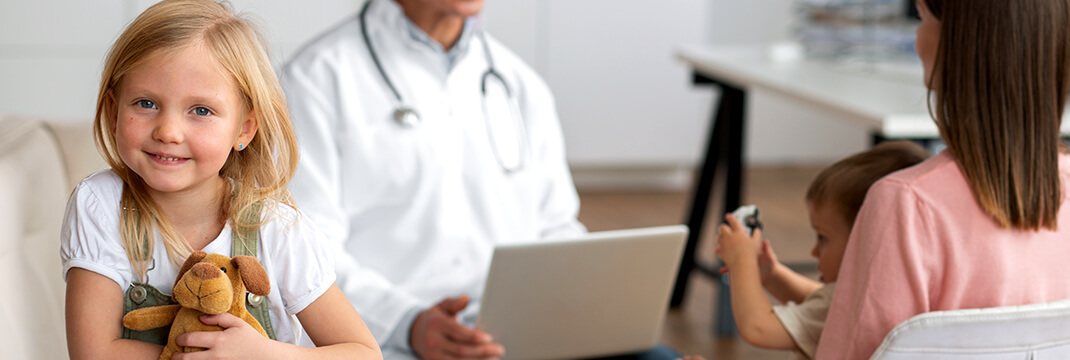
| Name: D.L. | Date: 12/10/2018 | |||||||||||
| Sex: Female | Age/DOB/ Place of Birth: 2 y/o, 12/10/2016, New Jersey | |||||||||||
| SUBJECTIVE | ||||||||||||
| CC: D.L., a 2-year-old infant, appeared in the clinic on the grounds that she was sick. Her father made complaints, “My daughter vomits and also has a fever for the past 8 hours.” | You may find this article Nursing SOAP Note Writing Service useful. | |||||||||||
| Child’s Profile:
Daily Routine: The patient loves to play with other children at home and in the daycare. The parent (father) normally wakes her up at 7 am and prepares her for daily activities. On the weekend, she can sleep in and remain with the babysitter. Safety: She takes boiled water and is not allowed to play in the mud or dust. The father ensures that D.L. wears heavy coats when there is a chilly weather. Developmental: The infant normally displays increasing independence in doing daily activities, such as brushing teeth. Furthermore, when playing with other children, she shows excitement and dominance. The infant can name familiar people in her life, for example, teachers, uncles, and even grandparents. She can name pointed things, including pictures and body parts. The father states that her daughter at times repeats what she hears from him or other people. The patient can point things in the book when they are mentioned, such as chairs, table, and animals. She can say a sentence with two or four words. Nutrition: The patient takes meals when she feels hungry, mostly which is 5 times a day. The father highlights that he provides her with proteins and water. |
||||||||||||
| HPI
The patient is a Caucasian female who currently is two years old. She began experiencing fever and vomiting 8 hours ago. The father stated that her last urine output was two hours ago. The father noted that the child looked more irritated when urinating compared to usual behavior. The patient’s vulva was sore after urination followed by dribbling of urine from the vagina. The father stated that after realizing this, he took her daughter to one of his sisters to analyze the infant before bringing her to the clinic for the medical check-up. On the analysis, the aunt identified certain issues which she explained to the father. She told that there was labial fusion. D.L. hardly resisted her aunt from pressing her private parts which made her aunt come up with the conclusion of a painless infection. The father was concerned and sought treatment for her daughter immediately. |
||||||||||||
| Medications: None | ||||||||||||
| PHM
Allergies: There are no known allergies noted. Medication Intolerances: No known MI. Chronic Illnesses/Major traumas: No known MT/CI. Hospitalizations/Surgeries: NKH/S. Immunizations: with age to date include; 12/10/2016
|
||||||||||||
| Family History
The patient is living with her father, K.J., in their rented home. The mother is deceased. The grandparents (paternal) are well and alive. On the maternal side, the grandmother was diagnosed with arthritis three years ago but was treated. Grandfather is well and alive. |
||||||||||||
| Social History
The patient’s father works as a supervisor in the Walmart supermarket. He took her daughter for the necessary vaccinations and is recorded to follow every step of the developmental milestone of the infant. The parent always checks on the safety of the child and ensures that she wears a helmet while riding her bike. |
||||||||||||
| ROS
Constitutional symptoms: The father specifies that the child is vomiting, has a fever which has maintained for the past 8 hours, and is irritable. He denies appetite loss or diarrhea. |
||||||||||||
| General
The infant has a noticeable fever and is vomiting. She also looks irritated and weak. |
Cardiovascular/ Peripheral Vascular
The father denies her daughter having orthopnea, cyanosis, palpitations of the chest, and abnormal sounds from the chest. |
|||||||||||
| Skin
The father denies ulcerations, swellings, pruritus, masses, lesion, burns, and lumps. |
Respiratory
The father denies breathing difficulties, cough, SOB, infections, flu, chest tightness, abnormal breathing sounds, or running nose. |
|||||||||||
| Eyes
The father denies conjunctivitis, photophobia, watery eyes, or eye infection. |
Gastrointestinal
The father admits vomiting and nausea which started 8 hours ago. However, he denies diarrhea, abdominal pain, irregular abdominal sounds, gas production, stomach irritation, stomach palpable masses, or stomach ulcerations. |
|||||||||||
| Ears
The patient recognizes sounds. |
Genitourinary/Gynecological
The father admits irritation while urinating, vulvar pain, labial fusion, dribbling of urine especially after urination, and adhesions. However, the father denies her daughter having pain, vulvar masses, or abnormal vaginal discharge. |
|||||||||||
| Nose/Mouth/Throat
The father denies throat infection, blue lips, tooth decay, nasal inflammations, discharge, masses, epistaxis, or ulcerations. |
Musculoskeletal
The father denies muscle cramps, myalgia, or back pain. |
|||||||||||
| Breast
The father denies erythema, palpable masses, tenderness, discharge, or lumps. |
Neurological
The child has no abnormalities. |
|||||||||||
| Heme/Lymph/Endo
The father denies heat or cold intolerances, anemia; however, he admits fatigue. |
Psychiatric
The father denies nervousness or insomnia.
|
|||||||||||
| OBJECTIVE | ||||||||||||
| Weight 23.2 lbs BMI 14.9 | Temp 102.8F | BP 88/55 mm Hg | ||||||||||
| Height 32 inches. | Pulse 110 per minute | Resp -29 | ||||||||||
| General Appearance
The patient is vomiting and developed a fever. |
||||||||||||
| Skin
No blue lips, fingernails, erythema, rashes, enanthem, lesions, ulcerations, or lumps. |
||||||||||||
| HEENT
Head- Head circumference is 18.1 inches. Unremarkable and normocephalic. Nose- No nasal pain, bleeding, or inflammations. Non-tender. Ear- No erythema, lump, or masses present. Tympanic membrane pearl-grey. Eyes- PERRLA, pupils normal bilaterally. No erythema, visual loss, or watery eyes. Throat- No lips and mouth of blue discoloration. |
||||||||||||
| Cardiovascular
S1 and S2 without rubs, murmurs, or gallops, RRR, well-perfused extremities, and clear auscultation. |
||||||||||||
| Respiratory
No coughs, SOB, difficulty in breathing, chest tightness, noisy breathing, discolored sputum, or chest pain. |
||||||||||||
| Gastrointestinal
No abdominal pain, watery stool, abnormal abdominal sounds, gas production, or diarrhea present. |
||||||||||||
| Breast
No palpable masses, lumps, erythema, discharges, lesions, or asymmetry. |
||||||||||||
| Genitourinary
Labial adhesions present, irritation, vulvar pain, difficulty while urinating, febrile, dysuria, joined inner lips, asymptomatic bacteriuria, urine dribbling, pain absent. |
||||||||||||
| Musculoskeletal
Full range of motion. No myalgia, kyphosis, joint swellings, or lordosis. |
||||||||||||
| Neurological
Looks fatigued, miserable, and inattentive. |
||||||||||||
| Psychiatric
The child is not playful and is easily irritated. |
||||||||||||
| In-house lab tests.
· Physical examination. · Urine catheterization. |
||||||||||||
| Pediatric assessment tools
1. Early Childhood Developmental Screening to identify immediate interventions that the infant requires based on her health issue (Moodie et. al., 2014). 2. Stages and Ages Questionnaire to identify important issues concerning the child. These include personal social development, problem-solving, communication, and fine motor skills of the child (Singh, Yeh, & Blanchard, 2017). |
||||||||||||
| Diagnosis | ||||||||||||
| Primary Diagnosis
· Labial Adhesions (ICD-10-CM, Q52.5) Labial adhesion is the possible cause of the child’s ordeal. She is having a fever and vomits. The patient has vulvar adhesions and pain, which supports the diagnosis. Furthermore, urine catheterization revealed increased leukocyte numbers. which proves an infection. Differential Diagnoses · 1. Urinary tract infections (ICD-10-CM, N39.0) This diagnosis is included based on the fact that it is directly related to labial adhesions (Goldman, 2013). However, physical examinations and urine catheterization prove that the infant does not have urinary tract infection. · 2. Gastroenteritis (ICD-10- CM, K52.9) This diagnosis has been included because the patient was vomiting; however, the data from both the objective and subjective analysis did not support it. The patient has no gastroenteritis issues, except for vomiting which was caused by GU. |
||||||||||||
| Plan/Therapeutics | ||||||||||||
| PLAN
Vaccine administered on this visit: According to Oldfield and Stewart (2016), vaccines are not recommended to be given to the infants with high fevers above 101F. The patient was supposed to be administered with Hep A and influenza vaccines today. However, she will be vaccinated when health conditions will be stabilized, which should happen three days from now. Vaccine forms issued: According to Ventola (2016), it is recommended to always issue parents with vaccine handout forms before vaccines are administered. Hence, the father will receive Influenza and Hep A handout forms before the vaccination is initiated. Medications: Premarin cream (estrogen containing cream) that should be applied twice a day until adhesion is resolved (Goldman, 2013). The baby should take Ceftriaxone 50-75mg/kg IV/IM every 24 hours for UTI infection (Robinson, Finlay, Lang, & Bortolussi, 2014). Laboratory tests: Leukocyte count test. Diagnostic tests ordered: Oestrogen level test (Knudtzon, 2017). Parent’s education: Soak the toddler in a warm bathtub before the application of estrogen cream. Teach the father to use a soft towel to dry the infant’s vulva and apply estrogen cream on the regions where labia are fused. He should be taught that this region is above the anus and that he should stop applying the cream once adhesions begin to separate. With regard to petroleum ointment (post-estrogen treatment), 2ml of it should be applied twice a day (Wejde, Ekmark, & Stenstrom, 2018). Non-medication treatments: To give the patient water to hydrate her. |
||||||||||||
| Follow-up:
The patient is supposed to RTC after 3 days for influenza and Hep A immunization. |
Self-Reflection
Having analyzed the case, I was shocked that infants could be diagnosed with labial adhesions. I thought that the disease was more common among adults or that it could be passed accidentally from an infected mother to a child during the delivery. This soap note proved to me that infants are also potential victims of labial adhesions. This infection should not be overlooked by doctors and nurses in their dealings with pediatric patients. It is important to regard it as a serious ailment.



